Moo!
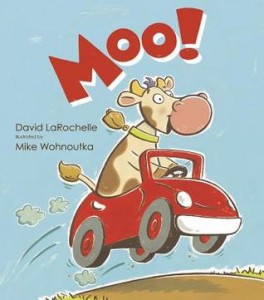 It’s the beginning of a new school year and we want all our students to start off feeling successful. If you have kids that are beginning or struggling readers, here is a book that almost everyone will be able to read confidently: Moo! written by David LaRochelle and illustrated by Mike Wohnoutka.
It’s the beginning of a new school year and we want all our students to start off feeling successful. If you have kids that are beginning or struggling readers, here is a book that almost everyone will be able to read confidently: Moo! written by David LaRochelle and illustrated by Mike Wohnoutka.
This is no boring “baby book”. The humor of this one works for a wide range of kids, especially if you model reading it aloud with great expression. I read this one for an all-ages Stories in the Park event this summer and even the grown-ups were chuckling. Even though the book consists almost entirely of one word, the punctuation, the text formatting, and the pictures determine how the word is read. So not only is it a bull’s-eye for the Core Standard of Fluency, it works beautifully into a lesson on punctuation and Print Concepts.
Read Moo! aloud to your students and, once the giggles die down, talk about how you knew how to read the same word differently. For example, look at this page from the book:  There are moos in italics, in bold font, in all capitals and these differences, along with the punctuation, help determine how to read this page. Share the book again, asking different students to use the text and picture clues to help them read the page with feeling. Now you’ve got a lead-in to a great writing exercise. Brainstorm two lists: a list of punctuation and text styles that were used to change the meaning of “moo” so many times, and a list of animals that make a sound. Kids can write and draw about an animal that goes off on an adventure (using punctuation and formatting to show meaning) and they’ll only have to worry about spelling one word. Fun!
There are moos in italics, in bold font, in all capitals and these differences, along with the punctuation, help determine how to read this page. Share the book again, asking different students to use the text and picture clues to help them read the page with feeling. Now you’ve got a lead-in to a great writing exercise. Brainstorm two lists: a list of punctuation and text styles that were used to change the meaning of “moo” so many times, and a list of animals that make a sound. Kids can write and draw about an animal that goes off on an adventure (using punctuation and formatting to show meaning) and they’ll only have to worry about spelling one word. Fun!
Dig in to fun summer books!
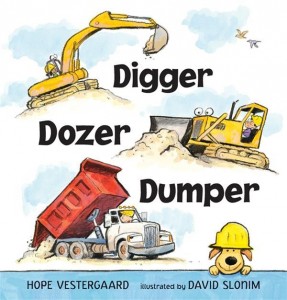
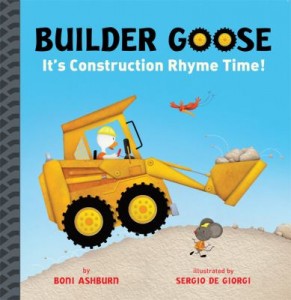 These books are so much fun I couldn’t choose just one! Now that summer is here, I’m looking for books that encourage outdoor play. Here are two books that will have kids scurrying to the sandbox: Digger, Dozer, Dumper written by Hope Vestergaard and illustrated by David Slonim and Builder Goose: It’s Construction Rhyme Time! by Boni Ashburn and illustrated by Sergio de Giorgi.
These books are so much fun I couldn’t choose just one! Now that summer is here, I’m looking for books that encourage outdoor play. Here are two books that will have kids scurrying to the sandbox: Digger, Dozer, Dumper written by Hope Vestergaard and illustrated by David Slonim and Builder Goose: It’s Construction Rhyme Time! by Boni Ashburn and illustrated by Sergio de Giorgi.
Both of these books have poems about construction vehicles, so by sharing them together you’ll not only hit Range of Reading, you’ll have great compare/contrast discussions which hit Integration of Knowledge & Ideas. (Also, both are written by Michigan authors, so shout out to the proud Mitten State!) I love that these books both give real information about how these machines work within fun, catchy poems. Dig these favorites:
Backhoe (from Digger, Dozer, Dumper)
The backhoe’s two machines in one:
a useful little truck.
His front end pushes dirt and rocks:
his back end digs out muck.
Heave Ho! Let’s Go! (from Builder Goose)
This old crane,
it swings wide!
It takes pallets for a ride.
With a heave ho, let’s go,
swing it back for more.
Hoist it high and watch it soar!
Once you and your crew have enjoyed the construction poems, everyone will want to go dig in the sandbox and build, dig, measure, and pour. Extend the learning and develop fine motor skills with these fun activities I found on preschoolexpress.com, Jean Warren’s genius website: hammer golf tees into firm Styrofoam pieces, screw screws into bars of soap, and build edible structures with graham crackers and frosting, peanut butter, or cream cheese. Happy reading!
Read More
“Rah, Rah, Radishes” and Go, STEM!
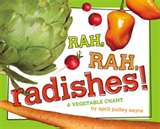 Happy May, everyone! I had the pleasure of speaking at an early education conference where our theme was literacy and science. I brought stacks of books that tie into STEM (Science, Technology, Engineering, Mathematics) or STEAM (add Art) to share. Rather than just lecture all day, I led a session of “speed-dating” books: we’d spend a few minutes skimming a book and brainstorming ways to use it with students, share our ideas with the group, and pass the book along. This way, we had time to get our hands on over a dozen books and walk away with practical classroom applications. I was so inspired by the fantastic ideas the teachers generated! Here are a few ideas we came up with after reading Rah,Rah, Radishes! A Vegetable Chant by April Pulley Sayre:
Happy May, everyone! I had the pleasure of speaking at an early education conference where our theme was literacy and science. I brought stacks of books that tie into STEM (Science, Technology, Engineering, Mathematics) or STEAM (add Art) to share. Rather than just lecture all day, I led a session of “speed-dating” books: we’d spend a few minutes skimming a book and brainstorming ways to use it with students, share our ideas with the group, and pass the book along. This way, we had time to get our hands on over a dozen books and walk away with practical classroom applications. I was so inspired by the fantastic ideas the teachers generated! Here are a few ideas we came up with after reading Rah,Rah, Radishes! A Vegetable Chant by April Pulley Sayre:
Bring in vegetables found in the book. Sort the vegetables by color and by size.
Classify and sort vegetables by the parts we eat: root vegetables, leaves, etc. Read Tops and Bottoms by Janet Stevens as a tie-in text and talk about which vegetables would be “tops” or “bottoms” according to Hare.
Predict which vegetables will sink or float. Test predictions in a tub of water. Wash the vegetables and talk about textures.
Use the vegetables to make prints.
Compare and contrast with fruits.
Weigh and measure the vegetables. Use a vegetable as a measuring tool.
Take photos of vegetables and label them. Reread the book and have students hold up the corresponding photos.
Make a chart or a Venn diagram with the terms “raw” and “cooked”. Try some vegetables both ways and chart our preferences.
See what other vegetables besides potatoes can be delicious mashed (great for little ones to do the mashing!)
Bring in potatoes with “eyes” sprouting and bring in vegetable seeds. Compare seeds and sprouts, then plant!
Make an edible collage with vegetables.
Practice patterning skills like ABAB, etc. with bite-size veggies and eat when done.
Plan a field trip to a farmer’s market or invite a farmer to come to the classroom for more vegetable experiences.
If you’re interested in the list of science books I shared, please email me at kristenremenar AT gmail DOT com. If you like Rah, Rah, Radishes! A Vegetable Chant, be sure to check out Go, Go, Grapes! A Fruit Chant and Let’s Go Nuts! Seeds We Eat also by April Pulley Sayre. Hooray for early science!
Read MoreHere Come the Humpbacks!
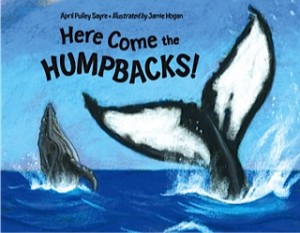 Happy March, everyone! This month I’m sharing a terrific informational picture book about humpback whales and a fabulous, free activity guide that will have your students up and moving as they process information. For those Nature Smart students who’re fighting the winter blahs, this kind of reading will be especially meaningful.
Happy March, everyone! This month I’m sharing a terrific informational picture book about humpback whales and a fabulous, free activity guide that will have your students up and moving as they process information. For those Nature Smart students who’re fighting the winter blahs, this kind of reading will be especially meaningful.
Here Come the Humpbacks! written by April Pulley Sayre and illustrated by Jamie Hogan is a nonfiction book detailing the migration of a humpback whale calf. Sayre gives us all the excitement of the treacherous journey that spans over 1,500 miles and doesn’t skimp on rich vocabulary or solid information.
After reading the book, your students can review what they’ve learned and “act out” the migration of a humpback. (Go, Key Ideas & Details!) Curious City has a wonderful, free humpback migration game you can download with step-by-step instructions and printables for 10 stations for students to visit. To add another layer of fun, go to YouTube and let kids hear the sounds that humpback whales make. (For more information about Curious City and its free children’s book engagement materials as well as book giveaways, please visit: curiouscitydpw.com. You’ll thank me later.)
I’ll be in New Jersey in April giving a seminar on early literacy skills for preschoolers and kindergartners. Please keep your fingers crossed that we’ll be enjoying tulip blossoms and not ice storms!
For more information about the author, please visit: aprilsayre.com.
For more information about the illustrator, please visit: jamiehogan.com
Read More







